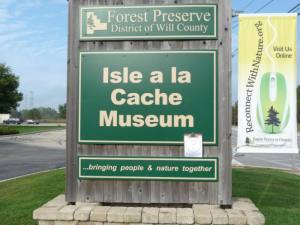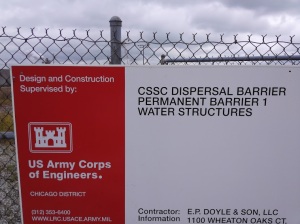 There was a sign along a back road on my way to Lockport, IL which said, “Isle a la Cache Museum.” What an invitation! I followed the sign. I pulled down a road leading to the Sanitary and Ship Canal to check out some construction I saw going on. I drove down the road towards an open gate leading down to the shore of the Canal. Signs on the fence announced that this was to be the permanent site of an electrified, underwater Asian carp barrier. This was my lucky day! I lurched over potholes to pull up next to a pick up truck sporting bumper stickers of the People Eating Tasty Animals variety. The truck was parked next to a trailer at the top of the south Canal shore precipice (the Canal was bordered by 8 foot tall limestone walls). I hailed the owner of the truck to ask where I could find some information on the barrier. He mentioned that I could drive over the bridge to the other side of the Canal and speak with the Army Corps Director of Operations, John McGowan. The construction worker mentioned that work had been slow due to heavy rains. I thanked him for the information and hopped back in the van towards the other shore of the Canal. I drove up to the considerably larger construction operation on the other side of the canal and asked another worker where I could find the Army Corps Director of Operations; he directed me towards the far end of the site and a trailer which resided there. I brusquely walked through a gate lined with, “No Trespassing: US Government Property,” signs and knocked on the door of the trailer. No response. I knocked again and louder this time. Still nothing. I shouted, “is there a John McGowan here.” Unfortunately, I was unable to reach anyone with the Army Corps of Engineers at the barrier site; not for lack of trying.
There was a sign along a back road on my way to Lockport, IL which said, “Isle a la Cache Museum.” What an invitation! I followed the sign. I pulled down a road leading to the Sanitary and Ship Canal to check out some construction I saw going on. I drove down the road towards an open gate leading down to the shore of the Canal. Signs on the fence announced that this was to be the permanent site of an electrified, underwater Asian carp barrier. This was my lucky day! I lurched over potholes to pull up next to a pick up truck sporting bumper stickers of the People Eating Tasty Animals variety. The truck was parked next to a trailer at the top of the south Canal shore precipice (the Canal was bordered by 8 foot tall limestone walls). I hailed the owner of the truck to ask where I could find some information on the barrier. He mentioned that I could drive over the bridge to the other side of the Canal and speak with the Army Corps Director of Operations, John McGowan. The construction worker mentioned that work had been slow due to heavy rains. I thanked him for the information and hopped back in the van towards the other shore of the Canal. I drove up to the considerably larger construction operation on the other side of the canal and asked another worker where I could find the Army Corps Director of Operations; he directed me towards the far end of the site and a trailer which resided there. I brusquely walked through a gate lined with, “No Trespassing: US Government Property,” signs and knocked on the door of the trailer. No response. I knocked again and louder this time. Still nothing. I shouted, “is there a John McGowan here.” Unfortunately, I was unable to reach anyone with the Army Corps of Engineers at the barrier site; not for lack of trying.
I closed out that particular side mission and got back on the short road to the Isle a la Cache Museum. I found the museum building nestled on an island between a split in the Des Plaines River. A beautiful location. The museum highlighted the relationship between French fur traders and Native Americans. As I was leaving the museum, the paddlers pulled up just outside the museum so I stuck around for lunch before heading out to Lockport. I scouted out the river near Lockport for somewhere the paddlers could pull off the river and get into town. Once again I was disappointed. There was no easy access to the Des Plaines River from Lockport.
 A lack of access to the river has become a theme for my journey on the roads paralleling it. Recreation along and within the river seems to have been forgotten, along with any connection to it. The city planners of Lockport, Romeoville, Lemont, or even the larger city Joliet did not involve the Des Plaines River in any way that I have noticed. Joliet exemplifies this exclusion as it is the first city to straddle the river on both sides since Chicago. I was fully expecting a large city park highlighting the Des Plaines River and Joliet’s rich history. At least some mention of the town’s namesake. There was a statue of Louis Joliet outside of the Public Library in town but nothing noticeable beyond that. It feels as if these towns are ashamed of their association with the river. And considering its present state, I am ashamed for them.
A lack of access to the river has become a theme for my journey on the roads paralleling it. Recreation along and within the river seems to have been forgotten, along with any connection to it. The city planners of Lockport, Romeoville, Lemont, or even the larger city Joliet did not involve the Des Plaines River in any way that I have noticed. Joliet exemplifies this exclusion as it is the first city to straddle the river on both sides since Chicago. I was fully expecting a large city park highlighting the Des Plaines River and Joliet’s rich history. At least some mention of the town’s namesake. There was a statue of Louis Joliet outside of the Public Library in town but nothing noticeable beyond that. It feels as if these towns are ashamed of their association with the river. And considering its present state, I am ashamed for them.
A healthy river reflects a healthy community. The vice versa, of course, is true as well. When a river system’s vitality gets ignored or, in the case of the Chicago and Des Plaines Rivers thus far, experiences active degradation from the surrounding communities. It hardly stands a chance.
Nick Ryan, Paddle Forward Support Team
No comments:
Post a Comment